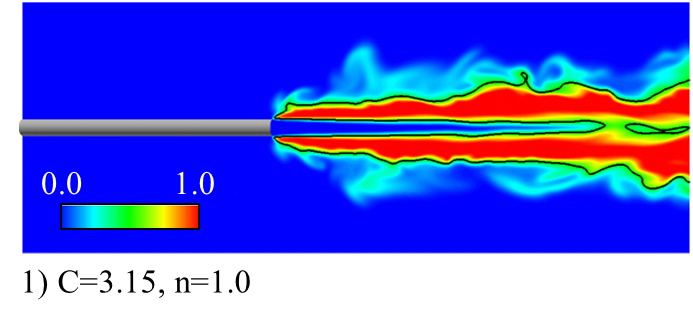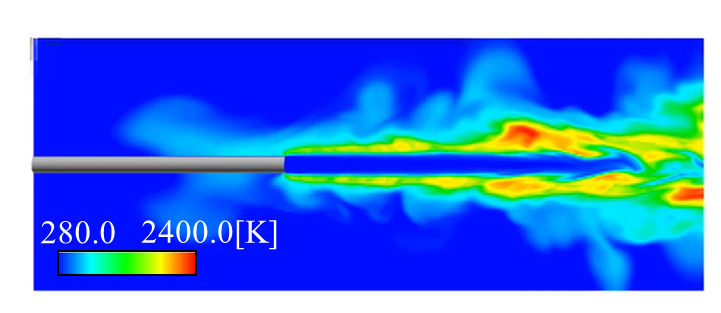Research on numerical simulation of combustion phenomena
JAXA Supercomputer System Annual Report April 2016-March 2017
Report Number: R16E0102
- Responsible Representative: Yuichi Matsuo(Aeronautical Technology Directorate, Numerical Simulation Research Unit)
- Contact Information: Himeko Yamamoto(himeko@toki.waseda.jp)
- Members: Himeko Yamamoto
- Subject Category: Basic Research(Numerical analysis)
Abstract
For the development of a jet engine combustor with high environmental compatibility, we develop the combustion calculation code that can capture the complex combustion field and the pressure propagation with practical calculation cost. In addition, a verification calculation of this calculation code is conducted on the hydrogen jet lifted flame.
Goal
For the development of a next generation low NOx combustor including a staged low emission combustor, development of the calculation code that can reproduce both the complex combustion field and the pressure propagation is intended to contribute to breakthrough in the Improvement of environmental compatibility at development of aircraft engines.
Objective
We develop a highly practical calculation code that can reproduce both the combined combustion field and the pressure propagation, and clarify the main mechanism of combustion oscillation which is a problem at actual combustor by numerical calculation in the low-swirl burner.
References and Links
N/A
Use of the Supercomputer
LES analysis in the jet lifted flame is conducted, using combustion calculation code which is developed based on the compressible fluid analysis solver FaSTAR (JAXA / Fast Aerodynamic routine).
Necessity of the Supercomputer
It is necessary to use supercomputer to conduct development and verification of the combustion calculation code.
Achievements of the Year
Based on the compressible fluid analysis solver FaSTAR, a combustion calculation code based on the Flamelet Approach/G equation was developed and a verification calculation was conducted for a hydrogen jet lifted flames. In the case of using only Flamelet Approach, good agreement with the experiment such as temperature distribution was seen (Fig.1). In addition, it was possible to confirm the lift-off of the flames to the turbulent combustion model in the result of the correction by the G value (Fig.2).

Fig.2: Scalar G distribution ( correction by scalar G, solid line: G=0.5, turbulent combustion model: damkohler model, C=3.15,n=1.0)
Publications
N/A
Computational Information
- Parallelization Methods: Process Parallelization
- Process Parallelization Methods: MPI
- Thread Parallelization Methods: n/a
- Number of Processes: 512
- Number of Threads per Process: 1
- Number of Nodes Used: 16
- Elapsed Time per Case (Hours): 48
- Number of Cases: 4
Resources Used
Total Amount of Virtual Cost(Yen): 3,134,498
Breakdown List by Resources
| System Name | Amount of Core Time(core x hours) | Virtual Cost(Yen) |
|---|---|---|
| SORA-MA | 1,784,623.18 | 2,924,293 |
| SORA-PP | 356.56 | 3,044 |
| SORA-LM | 0.00 | 0 |
| SORA-TPP | 0.00 | 0 |
| File System Name | Storage assigned(GiB) | Virtual Cost(Yen) |
|---|---|---|
| /home | 476.84 | 4,498 |
| /data | 19,531.26 | 184,238 |
| /ltmp | 1,953.13 | 18,423 |
| Archiving System Name | Storage used(TiB) | Virtual Cost(Yen) |
|---|---|---|
| J-SPACE | 0.00 | 0 |
Note: Virtual Cost=amount of cost, using the unit price list of JAXA Facility Utilization program(2016)
JAXA Supercomputer System Annual Report April 2016-March 2017



